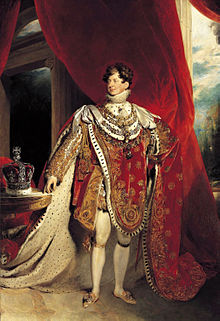In the early 19th century, British dandy Beau Brummell redefined and adapted a new style for men  , then popularised it, leading European men to wearing well-cut, tailored clothes, adorned with carefully knotted neckties. He claimed he took five hours a day to dress, and recommended that boots be polished with champagne.His style of dress is often referred to as dandyism.The simplicity of the new clothes and their sombre colours contrasted strongly with the extravagant, foppish styles
, then popularised it, leading European men to wearing well-cut, tailored clothes, adorned with carefully knotted neckties. He claimed he took five hours a day to dress, and recommended that boots be polished with champagne.His style of dress is often referred to as dandyism.The simplicity of the new clothes and their sombre colours contrasted strongly with the extravagant, foppish styles  just before. Brummell's influence introduced the modern era of men's clothing which now includes the modern suit and necktie. Moreover, he introduced a whole new era of grooming and style, including regular (daily) bathing as part of a man's toilet.Brummell was born in London, the younger son of William Brummell, a politician, of Donnington Grove in Berkshire.
just before. Brummell's influence introduced the modern era of men's clothing which now includes the modern suit and necktie. Moreover, he introduced a whole new era of grooming and style, including regular (daily) bathing as part of a man's toilet.Brummell was born in London, the younger son of William Brummell, a politician, of Donnington Grove in Berkshire.
 , then popularised it, leading European men to wearing well-cut, tailored clothes, adorned with carefully knotted neckties. He claimed he took five hours a day to dress, and recommended that boots be polished with champagne.His style of dress is often referred to as dandyism.The simplicity of the new clothes and their sombre colours contrasted strongly with the extravagant, foppish styles
, then popularised it, leading European men to wearing well-cut, tailored clothes, adorned with carefully knotted neckties. He claimed he took five hours a day to dress, and recommended that boots be polished with champagne.His style of dress is often referred to as dandyism.The simplicity of the new clothes and their sombre colours contrasted strongly with the extravagant, foppish styles  just before. Brummell's influence introduced the modern era of men's clothing which now includes the modern suit and necktie. Moreover, he introduced a whole new era of grooming and style, including regular (daily) bathing as part of a man's toilet.Brummell was born in London, the younger son of William Brummell, a politician, of Donnington Grove in Berkshire.
just before. Brummell's influence introduced the modern era of men's clothing which now includes the modern suit and necktie. Moreover, he introduced a whole new era of grooming and style, including regular (daily) bathing as part of a man's toilet.Brummell was born in London, the younger son of William Brummell, a politician, of Donnington Grove in Berkshire.
In this regency period, the predominant upper-class clothing introduced by Brummell for day wear was a tightly fitting, with non-matching (usually pale) trousers, pale waistcoat, white shirt and cravat and tall boots.
The linkage of clothing with political protest had become a particularly English characteristic during the 18th century. Given these connotations, dandyism can be seen as a political protestation against the rise of levelling egalitarian principles
Egalitarianism is a trend of thought that favors equality for all people. Egalitarian doctrines maintain that all humans are equal in fundamental worth or social status,
A dandy (also known as a beau or gallant) is a man who places particular importance upon physical appearance, refined language, and leisurely hobbies, pursued with the appearance of nonchalance in a cult of Self.Historically, especially in late 18th- and early 19th-century Britain, a dandy, who was self-made, often strove to imitate an aristocratic lifestyle despite coming from a middle-class background.Charles Baudelaire, in the later, "metaphysical" phase of dandyism defined the dandy as one who elevates æsthetics to a living religion, that the dandy's mere existence reproaches the responsible citizen of the middle class:
Aesthetics is a branch of philosophy dealing with the nature of art, beauty, and taste, with the creation and appreciation of beauty. It is more scientifically defined as the study of sensory or sensori-emotional values, sometimes called judgments of sentiment and taste. More broadly, scholars in the field define aesthetics as "critical reflection on art, culture and nature."
Aesthetics is a branch of philosophy dealing with the nature of art, beauty, and taste, with the creation and appreciation of beauty. It is more scientifically defined as the study of sensory or sensori-emotional values, sometimes called judgments of sentiment and taste. More broadly, scholars in the field define aesthetics as "critical reflection on art, culture and nature."
The Regency era in the United Kingdom is the period between 1811 and 1820, when King George III was deemed unfit to rule and his son, the Prince of Wales, ruled as his proxy as Prince Regent. In 1820 the Prince Regent became George IV on the death of his father.
The term, "Regency era", sometimes refers to a more extended time frame than the decade of the formal Regency. The period between 1795 and 1837 (the latter part of the reign of George III and the reigns of his sons George IV, as Prince Regent and King, and William IV) was characterized by distinctive trends in British architecture, literature, fashions, politics, and culture. If "Regency era" is being used to describe the transition between "Georgian" and "Victorian" eras, the focus is on the "pre-Victorian" period from 1811, when the formal Regency began, until 1837 when Queen Victoria succeeded William IV. If, however, "Regency era" is being contrasted with "the Eighteenth century", then the period includes the later French Revolutionary Wars and theNapoleonic Wars.In the English language the title Prince Regent is most commonly associated with George IV,  who held the style HRH The Prince Regent during the incapacity, by dint of mental illness, of his father, George III
who held the style HRH The Prince Regent during the incapacity, by dint of mental illness, of his father, George III  (see Regent for other regents). Regent's Park
(see Regent for other regents). Regent's Park ,Regent Street and Regent's Canal(which he commissioned) in London where all named in honour of him.
,Regent Street and Regent's Canal(which he commissioned) in London where all named in honour of him.
 who held the style HRH The Prince Regent during the incapacity, by dint of mental illness, of his father, George III
who held the style HRH The Prince Regent during the incapacity, by dint of mental illness, of his father, George III  (see Regent for other regents). Regent's Park
(see Regent for other regents). Regent's Park ,Regent Street and Regent's Canal(which he commissioned) in London where all named in honour of him.
,Regent Street and Regent's Canal(which he commissioned) in London where all named in honour of him.
This period is known as the British Regency, or just the Regency
1. What kind of fashion do you like
2,Why is it important to be "in fashion" or fashionable or cool
3. Do you think fashion goes together with what class you belong to? Does fashion classify you? Does it make you part of a certain group
4.Fashion has never been so important as it is now, why?
5. And why does fashion change quickly?
6. What fashion do you hate?
1 comment:
His style of dress is often referred to as dandyism.The simplicity of the new clothes and their sombre colours contrasted strongly with http://www.selong.org
Post a Comment